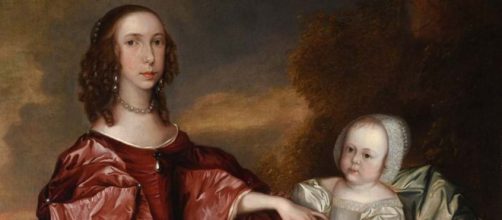The "Age of Innocence" reached its final end this week. You could see it in children’s watching eyes keeping vigil – fallout from the school massacres like the one in Uvalde, Texas this week.'
Remembrance of things past
The flip side of those wary faces surfaced the next day after the Uvalde murders at a London auction house selling “Portrait of Anne, Philadelphia and Thomas Wharton, later 5th Lord Warton.” This painting by 17th-century artist Joan Carlile (one of England’s first female portrait painters) set off the contrast between modern America and merry old England.
The expected sale price for “Portrait of Anne, Philadelphia and Thomas Wharton, later 5th Lord Warton” is reportedly less than $60,000 – a paltry sum for an Old Master. But female complaints aren’t the takeaway from this portrait. The guileless expression is.
Consider the 4th-grade boy who survived the mass shooting in Uvalde. He told a local station KENS 5 off-camera of hiding under a table with four classmates as the gunman walked into his classroom, saying “It’s time to die.” The boy saw his teacher and some classmates die.
You don’t see his face, but it’s fair to suppose that it’s quite the reverse of Anne, who lived a sheltered life as a member of the aristocratic Wharton family.
If that name sounds familiar, you’re likely thinking of Edith Wharton (no relation to Anne’s family), famed for her 1929 Pulitzer Prize novel “Age of Innocence.” How’s that for a coincidence?
'Age of Innocence' as sarcasm
Of course, Wharton’s meant her book title in an ironic way, disparaging the superficiality of New York society and the notion that anyone in that class was innocent. She borrowed the title from Mark Twain who also meant it as sarcasm in his scathing takedown of American tourists.
British painter Joshua Reynolds used the title “Age of Innocence,” too, though not in an ironic way. He used the title to tell of a little girl unstained by life, the archetypal face of childhood, far and away from the pomp that affluent clients liked to see in portraits of their children.
One might say Reynolds went overboard to de-glorify his portraits of children by idealizing them as if to push the point of purity.
But art historian Allan Cunningham notes Reynolds’ sincerity about depicting children pomp-free: “It was one of his maxims that the gestures of children are dictated by nature. He liked to observe children who came to his gallery mimicking the airs in the adult portraits.”
But even though Carlile’s “Portrait of Anne, Philadelphia and Thomas Wharton, later 5th Lord Warton” pictured the child festooned in satin and posed stiffly, she also captured the girl’s discomfort. You get the impression little Anne would like to stop posing and play with her friends.
In the end, then, both portrait paintings, Reynold’s and Carlile’s, serve as a keepsake of what we lost when children were innocent.


